CLP3305: Clinical Interview and Personality Assessment
1/56
There's no tags or description
Looks like no tags are added yet.
Name | Mastery | Learn | Test | Matching | Spaced |
|---|
No study sessions yet.
57 Terms
What is multi-cultural humility?
learning about own filters and continually challenge themselves to question assumptions.
• May require rethinking clinical diagnosis due to culture
– E.g. delusions and black magic
• May use brief personal disclosure to clarify, or discuss visible cultural differences.
What are the Types of Clinical Interviews?
1. Intake-Admission Interview
2. The Social History Interview
3. The Mental Status Examination
4. Diagnostic Interview
1. Intake-Admission Interview (Clinical interview)
→ Conducted when client first visits aclinic / is admitted to a hospital.
– Reason of client’s visit
– Determine whether the agency’s facilities, policies, and services meet the needs.
2. The Social History Interview (Clinical interview)
→ Details client’s personal history: facts, dates,
events
Covers broad range of material
– infancy, childhood, adolescence, adulthood
– educational, sexual, medical, parental-environmental, religious, and psychological matters.
• Adults with intact cognitive abilities interviewed
– Youth interviewed with “external informants” (aka. People who can inform about their symptoms such as parents, caregivers, etc.)
3. The Mental Status Examination (Clinical interview)
→ Assesses presence of in-the-moment cognitive, emotional, or behavioral problems.
Information gathered assesses
– Whether client experiencing acute psychosis
– Client’s general demeanor
• Also used within forensic settings
4. Diagnostic Interview (Clinical interview)
A diagnosis based on DSM-5 criteria.
What is the difference between structured and unstructured clinical interviews?
⭐ Structured diagnostic interviews ask a standard step of questions and follow up probes asked in a specific order.
→ Ex: “In the past two weeks, have you often felt down, depressed, or hopeless?” If “yes,” the next set follow-up question is: “How many days in the past two weeks?”
⭐ Semi-structure interviews as standardized questions living room for unscripted follow up.
→ Ex: “Can you tell me about times when you’ve felt anxious?” If the patient says, “Mostly at school,” the interviewer can follow up with unscripted questions like: “What about being at school makes you anxious?” or “Does this happen with friends too?
What is rapport in the context of clinical interviews?
An alliance between client and clinician characterized by acceptance, understanding, and respect.
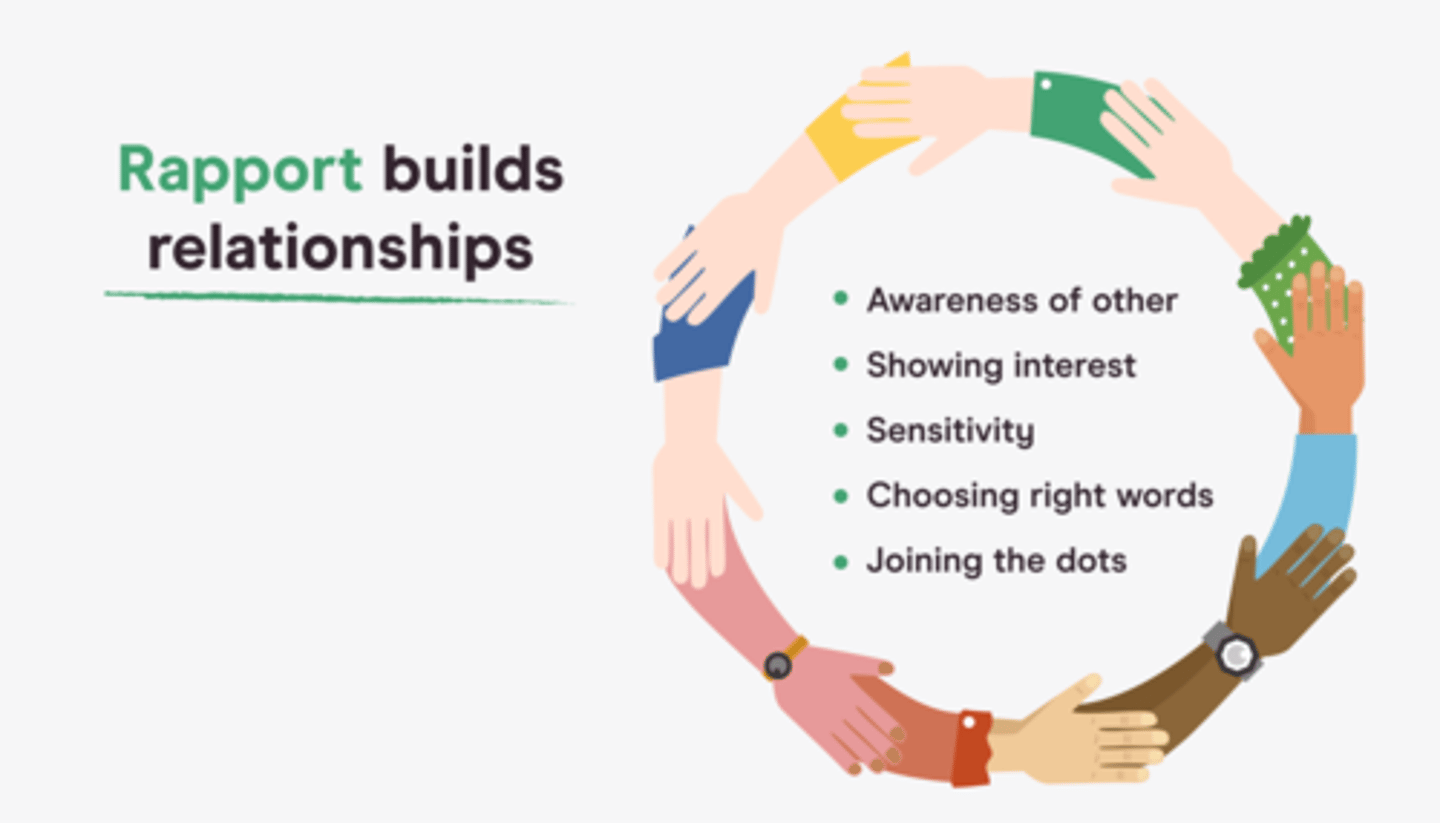
What are the limitations of structured diagnostic interviews?
Rigid, culturally insensitive; questions may be unclear, and not take cultural aspects to account.
What are the 13 major areas assessed in the Mental Status Examination (MSE)
1. General Presentation (appearance, behavior, attitude)
2. State of Consciousness (alert, hyperalert, lethargic)
3. Attention and Concentration
4. Speech (clarity, goal-directedness, deficits, rate, content)
5. Orientation (person, place, time)
6. Mood and Affect
7. Form of Thought (circumstantial, perseverative, self-referential)
8. Thought Content (preoccupations, obsessions, delusions)
9. Ability to Think Abstractly
10. Perceptions (hallucinations)
11. Memory (immediate, recent, remote)
12. Intellectual Functioning
13. Insight and Judgment
What are the Five Types of Interview Questions ?
1. Open-ended
2. Facilitative
3. Confronting
4. Direct
5. Clarifying questions
1. Open-ended (interview question)
- Begins discussion of a new topic
- Importance: Gives the client responsibility and latitude for responding
Example: “Would you tell me about your experiences in the army?”
2. Facilitative (interview question)
- Clarify, or guide clients
- Importance : Encourages the client’s flow of conversation
Example : “Can you tell me a little more about that?”
3. Confronting (interview question)
- Challenges inconsistencies or contradictions
- Importance: Forcefully guide flow of interview; may help client who experiencing a blindspot.
Example: “Before, you said you felt depressed all day long, but now you’re saying that you go out with friends and have fun every night. Can you help me understand?”
4. Direct (interview question)
- May help client who experiencing a blindspot.
Importance : Challenges appropriately once rapport has been established and the client is taking responsibility.
Example: “What did you say to your father when he criticized your choice?”
5. Clarifying questions (interview question)
- A part of active listening.
Importance: Encourages clarity or amplification
Example :“That sounds difficult. Can you tell me what it was like for you?”
What is Active Listening ? (Reflective listening)
→ Involves a technique referred to as reflection or Reflective listening, in which a psychologist repeats back what they heard the client say word for word or paraphrasing.
- Reliable weight of guiding course of interview
- Encourages warmth, openness, trust and rapport.
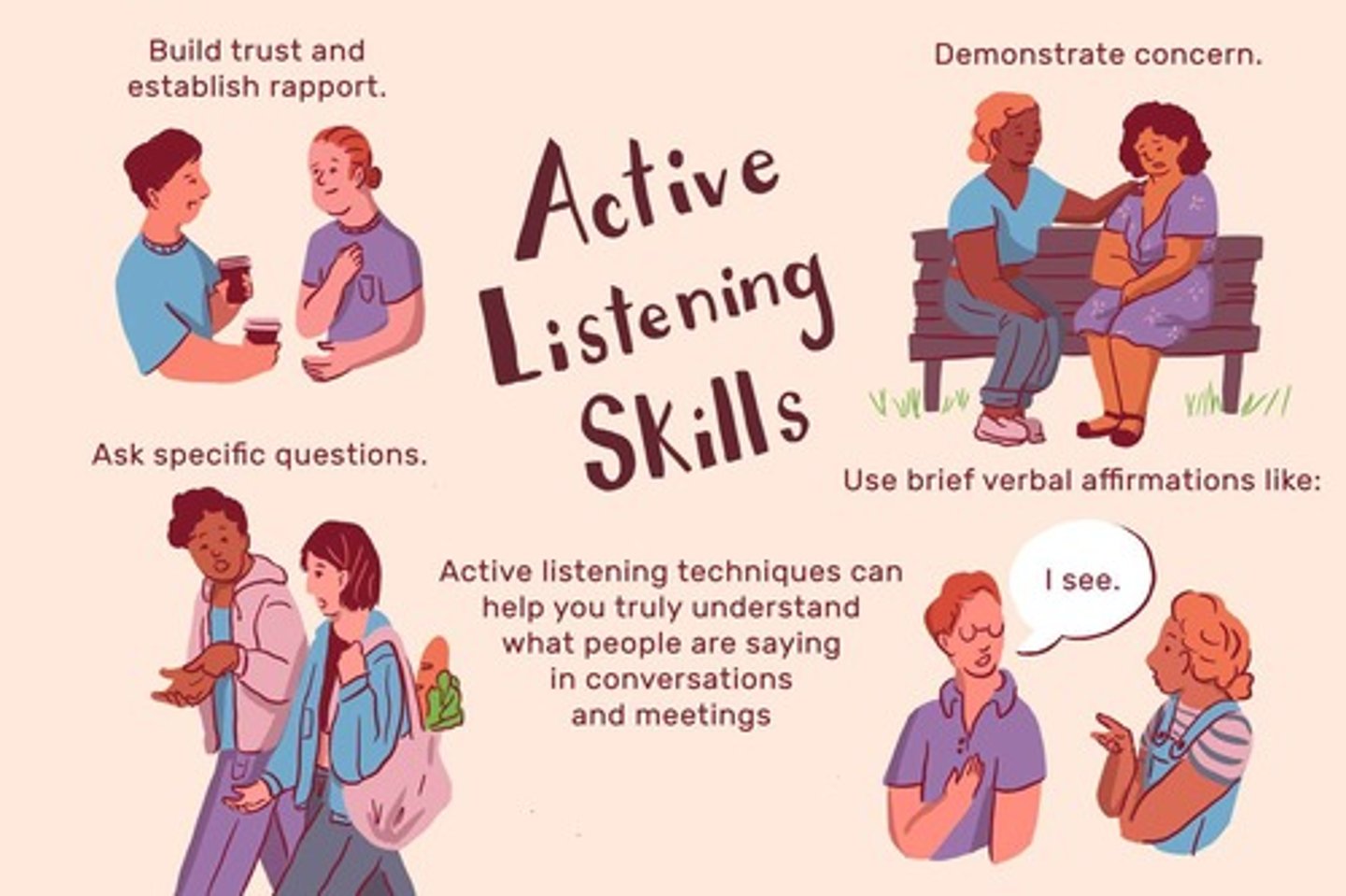
What is personality?
Continuity in a person's behavior and emotional style over time.
What is a personality trait?
→ Stable and consistent weight of perceiving the world in a behavior
- influenced by a environment, behavior or their combination.
- Have clinical significance
What are the goals of personality assessment?
1. To guide therapeutic interventions
2. Clarify clinical diagnoses
3. Predict responses in different situations.
Who was Hippocrates ?
- Proposed that the Imbalances of the body's humours, (blood, yellow bile, black bile, phlegm)
- lead to different personality (sanguine, choleric, melancholic, phlegmatic )
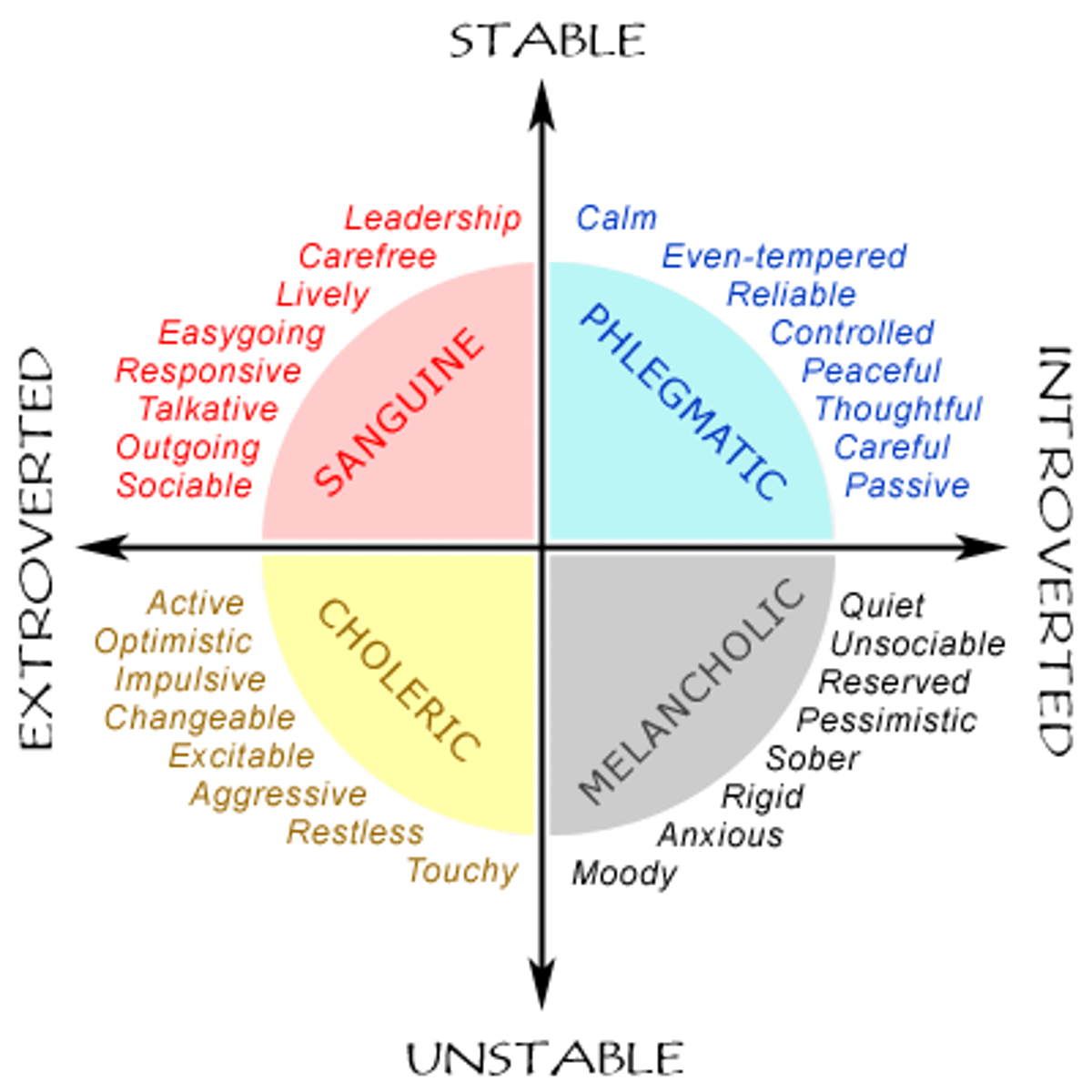
Who was Franz Gall?
- 18th century
→ Linking skull to personality
⭐ Neuroanatomist and father of phrenology.
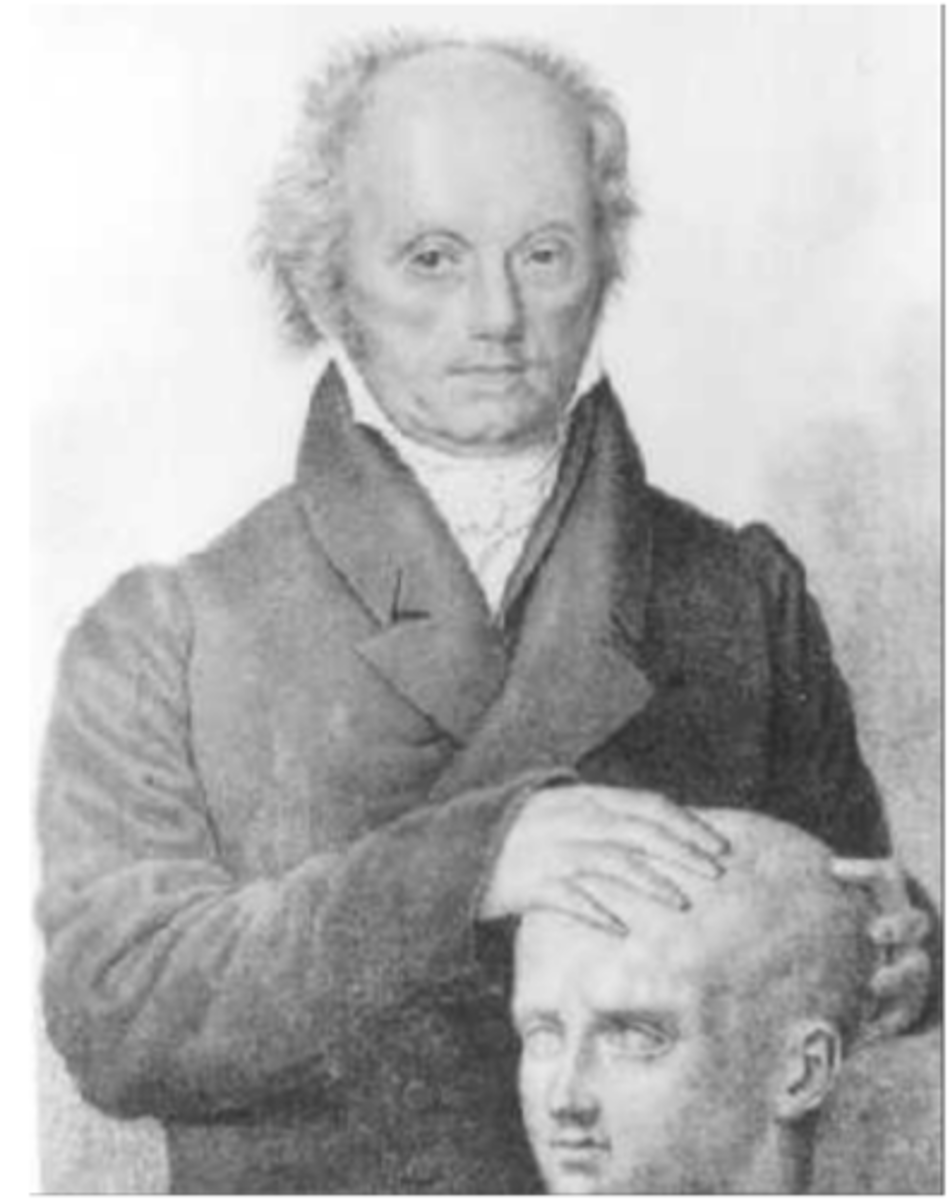
What is phrenology?
The practice of feeling for bumps on a person's skull to determine their intellectual and personality functioning).
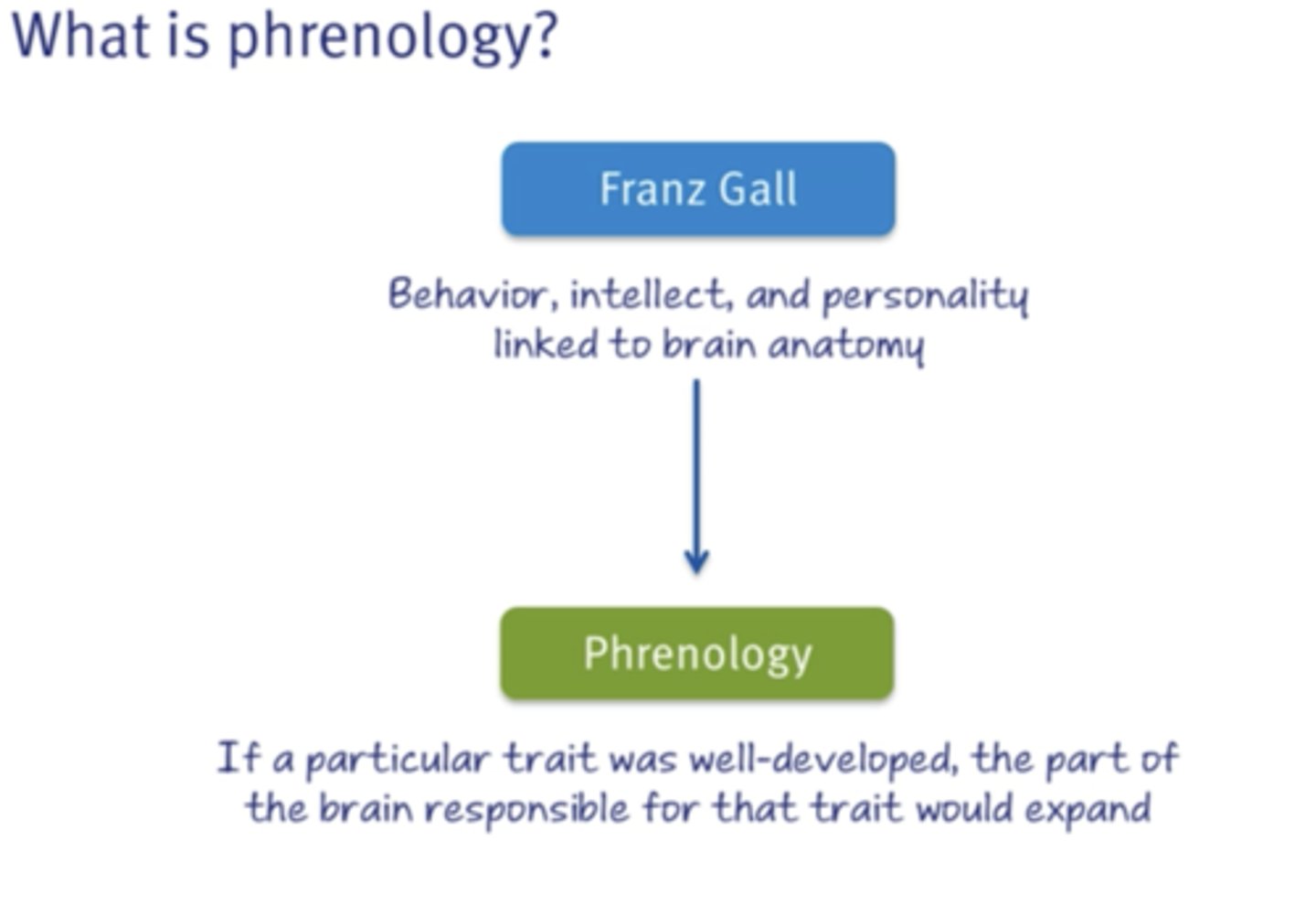
Who was Phineas Gage and why is he important?
- (1848) Was a railroad construction worker when an accident caused a tamping iron to be driven through the side of his face, behind his left eye, and all the way through the top of his skull.
- He recovered
-However, the brain injury from the accident seemingly resulted in changes in his demeanor:
- Once a moralistic and calm person, he became irreverent, impatient, and profane after the accident.
⭐ His case is one of the first to provide physical evidence that personality is linked to specific brain regions.
What is Freud's theory of personality called?
Psychosexual Theory of Personality.
Carl Jung
- Claimed individuals fall into dichotomous personality categories, such as introverted or extraverted.
- Inspired Myers-Briggs Type Indicator (MBTI) → widely used, but scientifically weak.
Trait theory
Gordon Allport (1930s): Trait theory → personality described with adjectives (e.g., self-confident, introverted).
Raymond Cattell
Developed 16-trait model of personality.
What does the five factor model (FFM) proposes?
Created by Costa & McCrae
- 5 dimensions/traits make up personality
- Person can be high or low on each, exist on a continuum
- Credit :overly broad
- Study in a adult adulthood– once traits are stable
What are the five dimensions of the Five-Factor Model?
OCEAN
Openness - Fantasy, Aesthetics, Feelings, Actions, Actions, Ideas, Values.
Conscientiousness - Competent, Order, Dutifulness Achievement Striving, Self-discipline, Deliberation.
Extraversion - Warmth, Gregariousness, Assertiveness, Activity, Excitement Seeking, Positive Emotions.
Agreeableness - Trust, Straightforwardness, Altruism, Compliance, Modesty, Tender-Mindedness.
Neuroticism -Anxiety, Hostility, Depression, Self-Conscious, Impulsiveness, Vulnerability.
Criticism: Broad categories; less useful before adulthood.
How does the situational perspective explain personality?
→ People’s behavior is entirely a product of situational factors such as learning and conditioning from the environment, rather than resulting from personality traits
- Behaviorist view of personality
- Behaviors learned through reinforcement
- Behavior also shaped by culture
Culture: shared belief, values, and norms
What is an example of personality vs situational factor explanation of behavior?
Scenario 1: A client misses three sessions in a row.
Personality explanation: The client is irresponsible or unreliable.
Situational explanation: The client had transportation issues, illness, or scheduling conflicts.
Scenario 2: A coworker shouts at his assistant during a meeting.
Personality explanation: The coworker has an aggressive or short-tempered personality.
Situational explanation: The coworker was under extreme stress, facing a deadline, or reacting to a specific frustration.
What is the middle ground?
Human behavior and emotions is an interaction of personality traits and situational factors.
What are the two main types of personality tests?
1. Projective tests
2. Objective tests
What are projective tests?
→ Presenting the test taker with ambiguous (e.g., vague, abstract, incomplete) stimuli and then assessing how the individual responds to such stimuli.
- Based on the projective hypothesis: which proposes that test takers will unconsciously reveal critical aspects of their personality.
- Derived from Freud's concept of projection
-Provide incremental validity
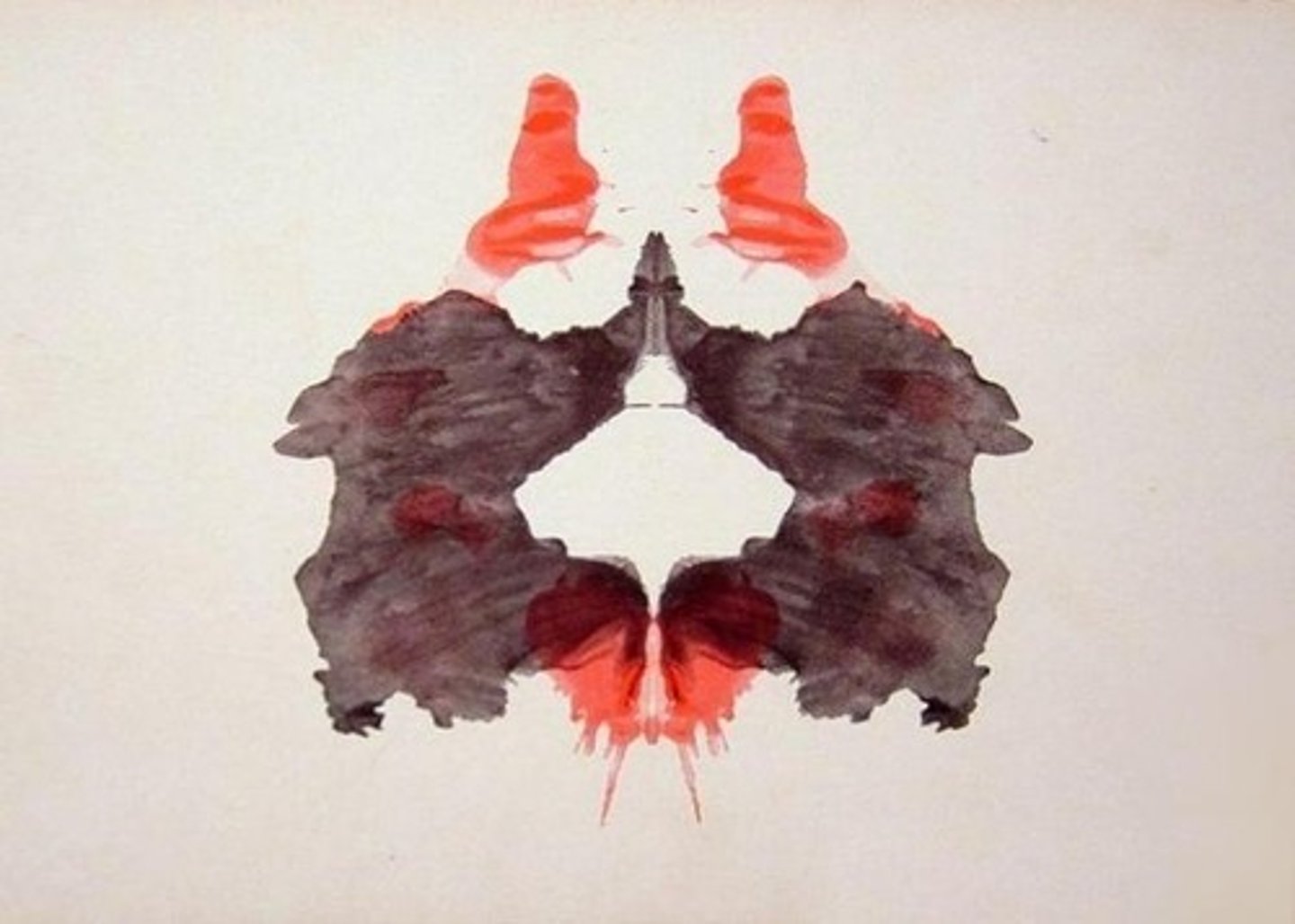
What are characteristics of projective test ?
Ambiguous test stimuli: (ink bots, incomplete sentence too complete)
Indirectness: respondents unaware of test purpose
Freedom of response; open ended test items
Qualitative response: interpretation
Lack of standardization, as every person is unique
Difficult to determine validity every reliability
What are requirements of useful personality tests?
1. Standardization: Follow same scoring and administration procedures each time.
2: Reliability: Similar results for same individual upon multiple testing.
3. Incremental validity: Provide information not provided by other sources: predicts persons future behavior.
- Helps clinicians to guide treatment.
Who was Herman Rorschach?
- The origins of personality testing trace back to him in the 1920s.
- Used inkblots for psychiatric diagnosis
- Observed responses of people to ambiguous situations (inblots).
What is the Rorschach Inkblot Test?
Type of Projective test
Description: These test has 10 printed inkbots.
- 10 black and white (and grays), 5 include colors.
Administration: Respondent tells what is seen
- Clinician records responses verbatim
Scoring: Location, Content, Determinants.

What is the Thematic Apperception Test (TAT)?
Projective testing that was created by Morgan & Murray (1935)
Description: 31 cards (one blank) of people of unclear gender in varied situation.
- Children versions depict animals.
Administrations:
- Clinicians select 6-12 cards
- Respondents storis transcribed verbatim
Purpose: Reveal basic personality characteristics through interpretation of responses to pictures.
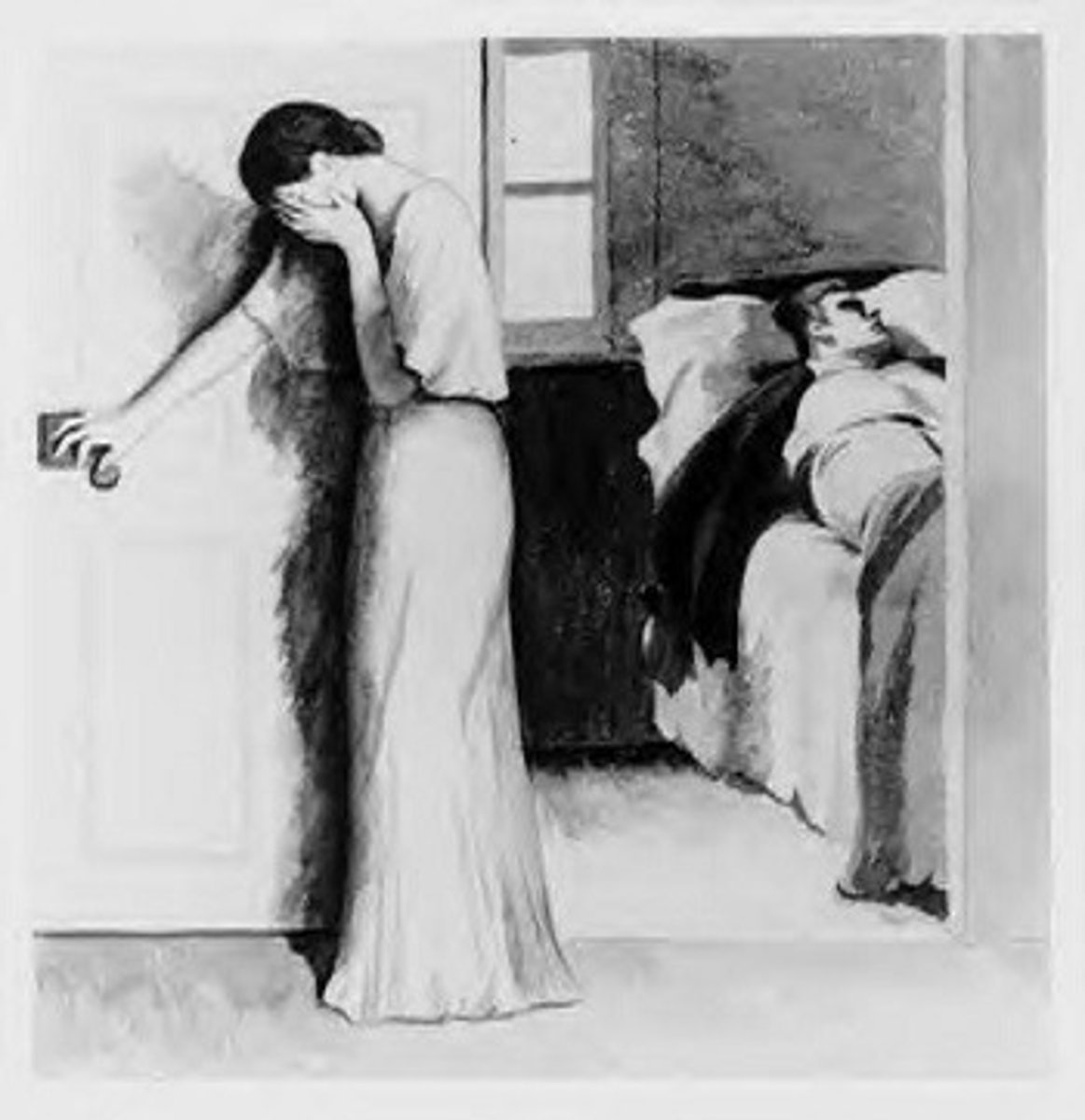
What is a significant challenge in establishing the reliability and validity of the Thematic Apperception Test?
There are many variations in instructions, methods of administration, and type of scoring systems/ interpretation system.
What are Objective test ?
Have standard question statements administered, with fixed- option responses.
What are the advantages and disadvantages of objective test ?
Advantages:
-Economical; be given to groups and individuals
-Brief instructions; simple scoring
-Objective and reliable.
Disadvantages:
- Responses may be not indicate actual behavior
- There can be several interpretations of same score.
- Respondents may fake responses
- Experiences, culture, and context can influence question interpretation and responses.
What is the content validation approach ?
It ensures a test adequately measures all aspects of the construct of interest.
Methods of content validation include:
- Carefully defining relevant construct aspect
- Assessing revelant construct aspects
- Evaluating their psychometric properties.
Limitations:
- Misinterpretation
- social Desirability
- People may not accurately describe behavior
- Expert reporting not accurate
What is empirical criterion keying?
→ Selection of items by members of different diagnostic groups
- Certain groups of people will respond to the test questions in the same way.
- Regardless of whether the items appear theoretically relevant to the diagnoses of interest.
- Utility determined by how much it can discriminate between different groups of people
Limitation
- Difficulty to interpret meaning of success
What is the purpose of factor analysis in psychological testing?
To determine whether potential items are related to each other.
What does the Gold Standard: Construct Validity Approach combine?
Combines all methods, of content validity, empirical criterion keying, and factor analytic approaches.
- Theory-driven
What is factor analysis?
A statistical method determining whether potential items are, or not, related to each other.
Strength: Empirically demonstrate items relate to each other.
Weakness: Unclear whether variables of interest are measured.
What is the MMPI and when was it developed?
Minnesota Multiphasic Personality Inventory 3
- Developed in 1943 by Hathaway and McKinley
-Used in clinical and research settings to predict different behaviors.
Updated and re-standardized over the years (2020- MMPPI-3):
• Has 335 items, 52 clinical and validity scales
• Respondents use paper- pencil or computer
• Updates use more diverse and representative standardization samples
• spanish translation and adolescent versions
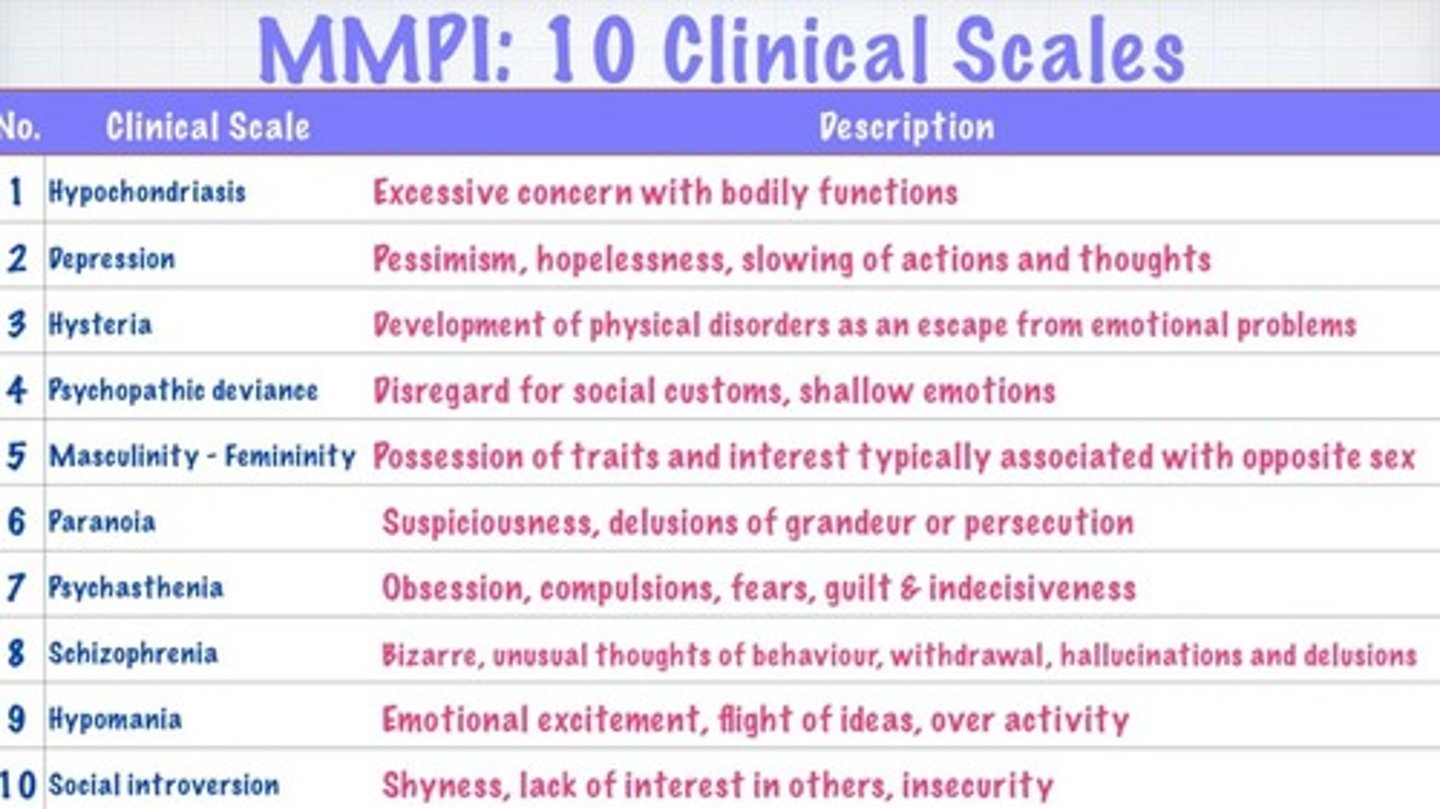
What is the Revised NEO- Personality Inventory?
Based on Five-Factor Model (Costa & McCrae).
- Self- report measure; 240 items on 5- point scale
- Have items reverse scored ( to adress bias)
- No validity scales included
- includes three items to assess response validity
u
Scoring and Interpretation
•Provides five domain scores
– six subscales, facets
Reliability and Validity
•High internal consistency; test-retest reliability
•Scores-related personality measures
•Useful clinically
Limitations
•Lacks validity items; developed for normal personality; insufficient clinical setting research
Discrimination and Bias in Personality Testing
Bias in Personality Testing
- Original test standardization samples were over represented by white middle class, educated, cis-gender heterosexuals.
Risks: Unfair outcomes for underrepresented groups.
Due to:
- Lack exposure to wording of test items
- Test materials biased to specific culture
What does and what does not constitute evidence for test bias?
Test bias: Different decisions or predictions are made for members of two groups, even when they obtain the same score on an instrument.
•Differences in mean scores do not necessarily indicate bias.
–Tests may be valid for (not biased) for some purposes, not others.
•Clinical psychologists should not make predictions based on empirical associations characteristic of another group.
what is Techniques (OARS)?
Open-questions
Affirmations
Reflections
- Simple – restatement of what was
said
- Complex – focus on affect underlying
what was said
Summarizing
What is motivational interviewing (MI)?
→ A collaborative, goal-oriented conversation designed to strengthen a person's motivation for change.
- Create an atmosphere of acceptance and compassion
- Developed by William R. Miller and Stephen Rollnick
What are the components of the MI spirit?
- Partnership, Acceptance, Evocation, and Compassion
What is the role of verbal and nonverbal communication in clinical interviews?
To establish rapport and effectively guide the flow of the interview.
__________ Has 335 items, 52 clinical and validity scales.
Minnesota Multiphasic Personality Inventory 3